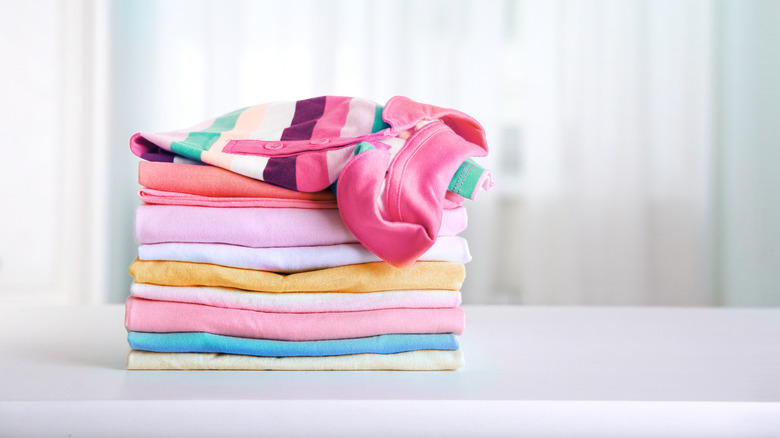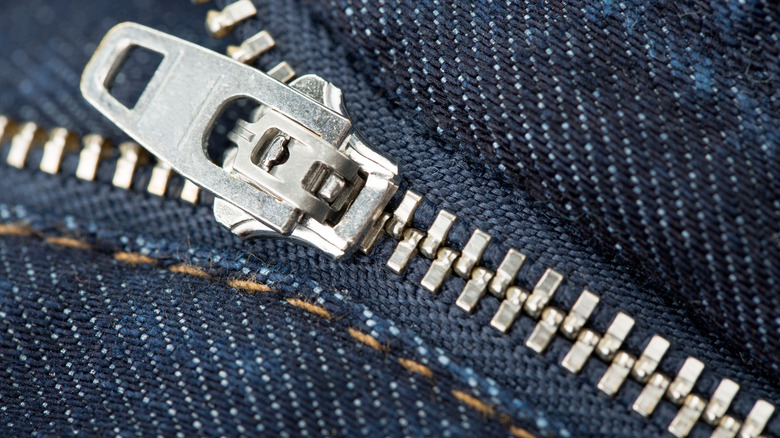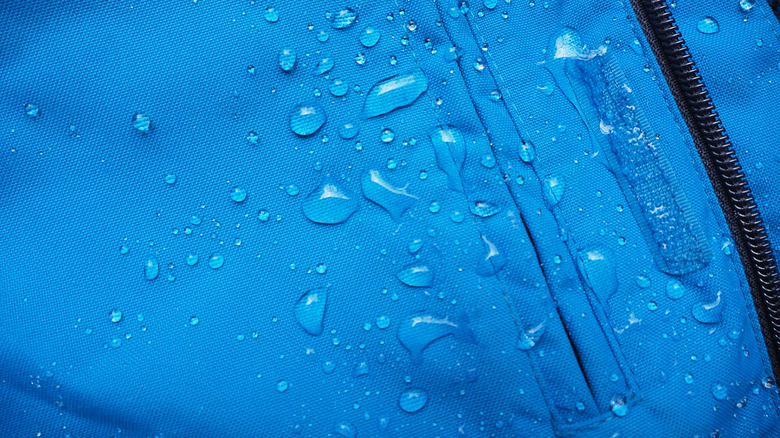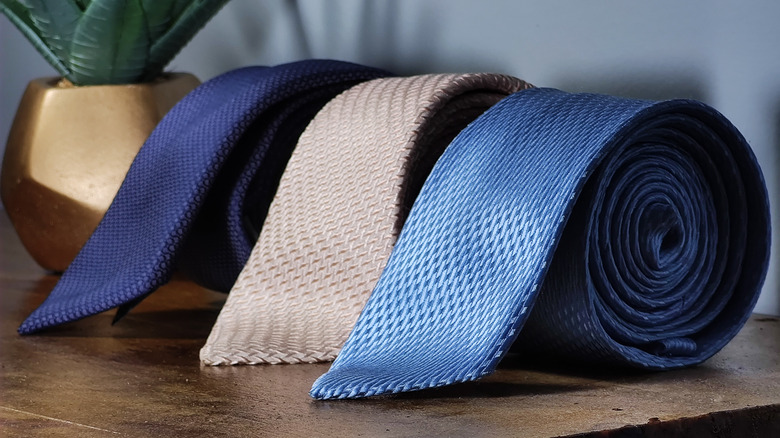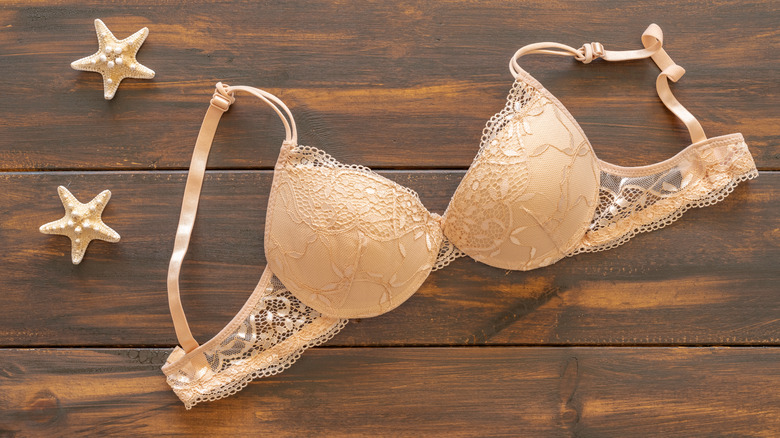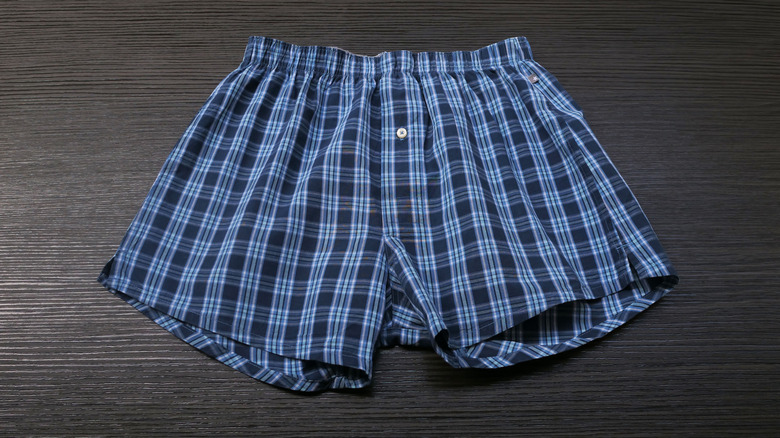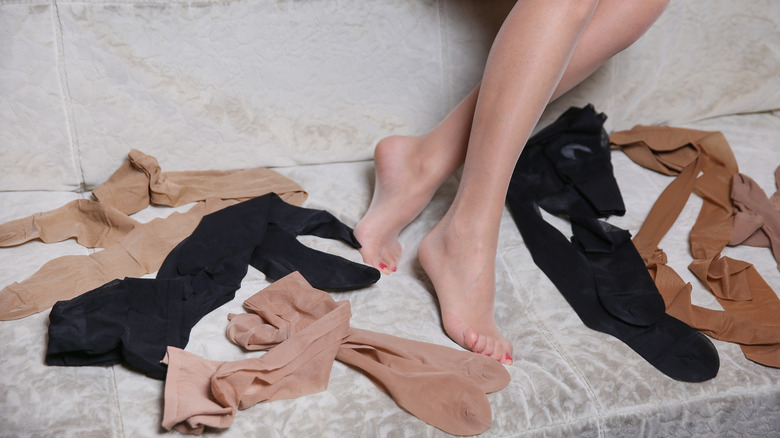Clothing Items You Didn't Know Were Bad For Your Health
What would you do if you won a gift certificate, but you had to spend it on one of the following items: a formal jacket, a casual T-shirt, or a comfy sweater? Now, let's look at this question another way. What conclusions might you draw if someone chose the jacket over the sweater or the T-shirt over the jacket? While there's more to someone than what they decide to wear, our clothing choices do make an impression. But, their impact on our lives sometimes goes beyond social interaction.
Take the classic stiletto, for example. This highest of the high heels can be a symbol of strength and sexuality. Appearances aside, however, they can also take a toll on your health. As WebMD explains, the very thin heels on stilettos can put all your bodyweight in one spot, so you'll run the risk of spraining your ankle. Plus, their shape puts pressure on the balls of your feet, which can cause hairline fractures. On the other hand, the polar opposite of stilettos, ballet flats, don't support your arches, which can cause issues with your back, knees, and hips.
The point is that many different types of clothing, including ones that are considered staples of fashion, can cause health problems. Will you start seeing symptoms the very first time you try something on? Not necessarily, but whether it's potentially bad for you in the short- or long-term, it's important to know what could be hurting you without you realizing it.
Yellow clothing
Over the years, we've heard about the possible dangers of food dyes, including that they can cause allergic reactions in some people. Unfortunately, even if you're not eating dyes, they can still get into your system via your clothes. Research by Rutgers University has found evidence that yellow dyes might cause serious health problems (via ABC News).
According to the study, the real culprit is a chemical called PCB 11, which is often a component of dyes that give clothing like T-shirts their bright, sunny color (via ABC News). But, wait — aren't PCBs banned in the U.S.? Technically, yes, because of the Toxic Substances Control Act of 1979. Yet, there's a catch. While a company is not legally allowed to put PCBs into a product, there is no law preventing them from using a product where PCBs could be an unintended byproduct.
So, how dangerous could a little yellow dye be? Well, other research has found connections to PCB 11 and birth defects and cancer, as well as severe acne breakouts and skin irritations (via ABC News). And, the news gets worse from there. Yellow dyes that contain PCB 11 aren't just found in clothing. You can have contact with it from other cloth-based products like towels and paper products like a typical lined notepad. Even yellow paints may contain this chemical. However, before you throw everything that's yellow out of your home, keep in mind that not all yellow dyes contain PCB 11.
Leggings
Okay, let's address a concern about leggings raised by physiotherapist Sammy Margo. In an article in the Daily Mail, Margo says tight leggings hold your muscles in place and "as a result, the muscles are allowed to relax and switch off ... so they are not as svelte or firm as they otherwise would be." However, weight loss expert Dr. Jana Klauer called this idea "ridiculous," stating, "There's nothing in leggings that would cause any change to occur within the muscle or the fat of the leg," to NBC News. Exercise physiologist Felicia Stoler agreed, adding that our muscles work when you use them, not by putting on certain garments. Muscle tone aside, there is an irrefutable way that leggings can be bad for your health.
Dr. Josh Zeichner, the director of cosmetic and clinical research in dermatology at Mt. Sinai Hospital in NYC, told Cosmopolitan that the tight nature of leggings means their material is right up against your skin — and so is any perspiration and body oils trapped in them — which is a recipe for ringworm and other fungal infections. In addition, working out leggings could lead to vaginal yeast infection.
To avoid infections, wear a fresh pair of leggings every time you work out (via Cosmopolitan). And, even though they are super comfy, staying in them all day, especially when the weather is warm, could be inviting health problems. Finally, buy leggings made from breathable fabrics.
Clothes with metal fasteners
Imagine this: a person has a favorite brand of jeans. Whenever they shop for clothes, they know that this particular company's jeans will always fit right and look good. So, not surprisingly, they often choose a pair of these jeans when they're getting dressed. Then, one day, they notice a red rash on their stomach that seems to line up with their jeans' zipper and button. But, they've been wearing this brand for years. It couldn't suddenly be giving them a rash, could it?
Unfortunately for the person in this scenario, they have developed an allergy to products made from nickel, according to the Mayo Clinic. Since this brand of jeans has been their go-to clothing item, they've frequently exposed that part of their stomach to the nickel in the jeans' zipper and button. Over time, this led to them becoming permanently allergic to nickel.
Besides the metal zipper and button in jeans, nickel is used in other clothing items like the hooks on bras and the buckles on belts (via Mayo Clinic). It also can be found in other types of metal fasteners like the snaps used on some shirts and jackets. Telltale signs you have a nickel allergy include your skin becoming itchy and developing dry patches and blisters. And beware, the skin affected by a nickel allergy can become infected. If your skin becomes more red, painful, and/or warm, and if you notice pus, immediately contact your healthcare professional.
Waterproof, stain-resistant, and wrinkle-free clothes
It's easy to see the upsides to specially-treated clothes. The less they stain, the longer they'll last. The less they wrinkle, the better they'll travel especially on a business trip. And who would want to buy a raincoat that isn't waterproof? But, despite all these pluses, the very chemicals that make these clothes desirable can also make them possibly hazardous for your health.
According to Business Insider, if an item of clothing is resistant to staining and wrinkling, it might contain formaldehyde. If that chemical's name sounds familiar, it's because it's also used to embalm dead bodies. For the living, formaldehyde has been connected to health problems like cancer and asthma. To be fair, these problems are usually the results of breathing in formaldehyde gas, but skin irritations ranging from dry skin to blisters can occur from clothing containing formaldehyde.
In addition, per- and polyfluoroalkyl substances or PFAS are used in some clothes advertised as less likely to stain and waterproof (via Business Inside). These toxic chemicals have been connected to several serious health problems like cancers of the testicles and the kidneys (although these issues usually occur as a result of ingesting it). The good news is many PFAS are no longer being used in manufacturing and, because of regulations, the levels of formaldehyde and PFAS you may encounter will in all likelihood be low. Nevertheless, constantly wearing waterproof, stain-resistant, and wrinkle-free clothes means prolonged exposure to these chemicals.
Neckties
For some men, ties are an uncomfortable part of looking professional. But that piece of clothing they're putting up with in the name of business could actually be hurting their brain and eyes. And, no, this has nothing to do with an ugly tie pattern or design.
Research conducted by Kiel University Hospital scientists found that wearing a tie can decrease the blood flow to your brain by as much as 7.5% (via Business Insider). If you combine this reduction in blood with other health concerns, like high blood pressure, you could find yourself getting dizzy or queasy at that important business meeting. As for your eyes, another study found that the restriction of blood caused by ties can raise the pressure in your eyes, increasing your chances of developing cataracts and glaucoma.
Besides how tightly you tie your tie, research by Texas A&M Health Science Center College of Medicine found that 42 surgical technicians had pathogens on their ties (via Business Insider). "Hospital-acquired infections account for a large proportion of high rates of morbidity, mortality, and costs," according to Orly Tamir, Daniel Henderson, and Eyal Zimlichman, who conducted the study. Even if you don't work in a hospital, you may want to not wear the same tie more than one day in row. In addition, you should wash your ties like you would other items of clothing.
Bras
Let's be clear about one thing — bras that fit correctly should not lead to any health problems, reports Medical News Today. In fact, wearing a sports bra can make exercising more comfortable because it offers additional support and, so, reduces breast pain. But, picking the wrong bra can be a pain in the neck — literally.
As Medical News Today explains, ill-fitting bras can lead to discomfort in the neck, as well as pain in the muscles in the upper torso. And, while it's annoying when bra straps slip off your shoulders, tightening them up too much can cause grooves that never go away. If that's not a concerning thought, then how about this? The wrong bra can lead to unnecessary surgery. One study involving 102 females having breast reduction surgery found they all were wearing bras that didn't fit them correctly. Keep in mind that a major reason why someone has this type of surgery is because they're in pain. However, in some cases that pain may have less to do with the size of their breasts and more to do with their bra not them correct support.
In addition, a study found that wearing a bra or a snug top to bed could lead to less sleep (via Medical News Today). And, no, it's not a question of comfort. Tight-fitting clothes cause a chain reaction in your body that makes your melatonin levels drop, leading to less restorative sleep.
Bathing suits
If your bathing suit fits you snugly and is made from stretchy material, then you need to ask yourself a very important question. Do you have eczema? In case you're not sure, eczema is a skin condition where your skin can become inflamed and develop lesions, according to Medical News Today. Not a pleasant thought and, unfortunately, the very things that make so many bathing suits perfect for a day at the beach or pool also make them potential irritants for eczema.
According to textile designer Kara Cirese, the blends of textiles used in some bathing suits can be made from petroleum, which can aggravate the skin of someone with eczema, reports the National Eczema Association. These possible materials include polyester and neoprene, both of which can trigger an eczema-based skin reaction known as textile dermatitis. And, to make matters worse, tight-fitting suits mean these potentially irritating materials are constantly rubbing against the skin. So, while certain spots like the tops of the legs are more likely to form eczema lesions, technically every bit of skin covered by a bathing suit is vulnerable.
If you have eczema and love to swim, don't resign yourself to giving up your favorite hobby just yet. There are bathing suits made from materials less likely to trigger an eczema attack like bamboo, hemp, and cotton (via National Eczema Association). Yes, buying off the rack might be a bit more challenging, but the extra effort will be worth it to enjoy a stress-free day swimming without any skin issues.
Rompers
For some, rompers are the perfect marriage of style and comfort. That is until nature calls. These one-piece fashion staples become very inconvenient when it's time to use the bathroom. And, the small (and sometimes not-so-sanitary) stalls in public restrooms add a whole new level of difficulty to relieving oneself. So, it's not surprising that some women decide it's better to "hold it" and be a little uncomfortable than go through the hassle.
Unfortunately, not using the bathroom when your body needs to can be taxing on your health. Remember, urine is waste material that is not good for our bodies. As Dr. Jill Rabin, professor of obstetrics and gynecology at Hofstra North Shore-LIJ School of Medicine in New York, tells Cosmopolitan, keeping that urine inside our bladder for longer than it should be can lead to bladder infections. Signs of such infections include fever, lower back pain, discomfort around the pubic bone, and painful intercourse.
One more word of caution: Cutting back on your liquid intake, so you won't have to urinate as much isn't a good strategy. Not only can this make an existing bladder infection worse, but it can also make your digestive system more sluggish and throw off just about all of your bodily functions (via Cosmopolitan). Not to mention, you could become dehydrated, which can cause a number of health issues.
Skinny jeans
Jeans are a staple of American fashion. They come in a variety of sizes and styles, so you can choose the most flattering and comfortable look for your body type. They're made of denim, so they're durable and more likely to last over other more delicate fabrics. And, they can run the gambit between playfully dressy and ridiculously casual. But, for one woman in her mid-30s, a pair of skinny jeans led to serious medical complications.
According to Verywell Health, this unfortunate individual was walking home after helping someone move when her feet suddenly went numb and became partially paralyzed. She fell and, since she was alone, she was unable to get help. Hours later, she was found and taken to the hospital where she was diagnosed with compartment syndrome — a condition that causes a back-up of blood in the circulatory system. The effects of this ailment can be severe and include muscles breaking down (which this woman experienced to some extent) and impaired kidney function (which she would have experience if she hadn't been taken to the hospital). It was determined that wearing her skinny jeans while doing strenuous moving-related activities was what caused her compartment syndrome.
Fortunately for this woman, she only needed intravenous fluids and a brief stay in the hospital. However, for some with compartment syndrome the only solution is surgery (via Verywell Health). And, of course, she needed to immediately stop wearing her skinny jeans, which were cut off her swollen legs.
Wool sweaters
Wool is a notoriously warm, yet itchy fabric. But, for some people, woolen products like sweaters are more than just a little uncomfortable. In fact, they may have a sensitivity or even an allergy to any type of clothing made from wool.
Now, as Healthline explains, there has been some question over the year if people are really allergic to wool. A rash (no pun intended) of negative allergy tests in the 1930s led many to believe that wool wasn't the true culprit, and some have even looked into a substance that coats wool called lanolin as the potential source of some people's symptoms. Regardless, a wool allergy is far more serious than being sensitive to wool and should not be ignored. If your nose runs and your eyes become irritated every time you wear a particular wool sweater, that could mean you have the allergy. Other signs include rashes and itchy skin.
While you should see your healthcare professional if you suspect you're allergic to something, there are ways you can test to see if you have a wool allergy at home (via Healthline). Try wearing a thick piece of clothing under your wool sweater and see if you have a reaction. If you don't, it may be your sensitive, but not allergic, to wool. Also, if taking off your wool sweater immediately reduces or eliminates your symptoms, then you're probably only sensitive to wool.
Compression socks
In the Broadway hit musical "Wicked," the title character sings about "defying gravity." Right now, your heart is literally defying gravity. As Healthline explains, when you pump blood through your arteries and veins, you are fighting against the natural pull of gravity. Of course, this can wear out your circulatory system over time, but using compression socks can add a little pressure to the right spots on your lower leg to keep your blood moving. However, these sometimes-useful articles of clothing can be the source of a host of health issues.
According to Healthline, wearing compression socks (and, in particular, wearing ill-fitting compression socks) can cause bruising, chaffing, itching, and redness, as well as infections due to broken skin. In severe cases, they can even cut off your circulation, which, if not addressed quickly, can permanently weaken your limbs. Besides making sure you're wearing the right-sized compression sock, Healthline also cautions against using old, overly worn socks since they can also cause the above issues. Also, change your socks daily not only to avoid compression sock-related health problems but also because it decreases your chances of developing strong foot odor.
If you think compression socks may be helpful for you, talk with your health care professional about medical-grade ones (via Healthline). They may be able to write you a prescription for these socks, which might mean that the cost for them is at least partially covered by your health insurance.
Clothing with elastic bands
It's common to see doctors, nurses, and dentists wearing medical gloves made of latex. But, that's hardly the only product where you'll find this natural rubber. If your underwear has an elastic waistband, for example, you're wearing latex, according to Healthline. And, if you have a latex allergy, then you could experience some unpleasant health problems.
According to Healthline, a latex allergy can cause hives and rashes. You also may experience eczema — a condition where your skin becomes cracked. Usually, these problems occur where the latex in the elastic band makes contact with your skin, but you also may feel itchiness in your hands. While, sometimes, the reaction is immediate, symptoms might not appear for hours after initial exposure. Fortunately, such skin problems usually go away either on their own or in the case of rashes with topical treatments, like calamine lotion or hydrocortisone cream. Unfortunately, your underwear isn't the only possible source of latex you might encounter in your wardrobe.
As Healthline explains, elastic bands containing latex are commonly used in other clothing items like pants, raincoats, and running shoes. So, if you think you have a latex allergy, see your healthcare professional and have an allergy test done. If it comes back positive, then you may want to wear a medical ID bracelet since latex is also in items commonly used in dentist offices like orthodontic rubber bands, as well as in hospitals like intravenous tubes.
Pantyhose
Ask anyone who has to wear pantyhose on a regular basis, and they'll probably give you the following two cons: they can be uncomfortable, and they get runs in them easily. However, these form-fitting garments can also cause multiple health issues.
As Dr. Radhika Rible, an ob-gyn and assistant clinical professor at UCLA Medical Center in Los Angeles, tells Everyday Health, pantyhose can cause yeast infections and UTIs (urinary tract infections). How? Their stretchy, flexible material, plus heat and your body's sweat, can create the perfect conditions for yeast and bacteria. Of course, wearing underwear or pantyhose with a cotton crotch can make this scenario less likely to occur. But going commando under your pantyhose could be inviting these ailments.
Besides infections, the latex found in some pantyhose can cause rashes, especially if you have a latex allergy, sensitive skin, or eczema (via Everyday Health). And, as much as tight pantyhose can be uncomfortable, getting a larger size can also cause problems. Specifically, if you wear pantyhose that are so big that they creates folds of material around your ankles, you could give yourself calluses. This can also happen if you wear shoes that are too large for your feet while wearing properly-sized stockings. So, make sure to discard pantyhose once they become stretched out. And, to avoid infections, wash your pantyhose after wearing them, either by hand or in a washing machine on the gentle cycle.
Leather jackets
Certain characters are known for their clothes. For Dorothy, it's her ruby slippers. For Sherlock Holmes, it's his deerstalker hat. And for a certain bad boy with a heart of gold on "Happy Days," it's his leather jacket. Sorry, Fonzi, your iconic outerwear can cause health problems.
According to the NY Allergy & Sinus Centers' website, some people can have an allergic reaction to leather, leading to painful symptoms on the wrists, hands, or feet ranging from peeling, burning, and dry skin to a dark or red rash. Specifically, people who have a strong reaction to leather products like jackets may be allergic to a chemical used to tan leather called dimethyl fumarate or DMF. Unfortunately, what can make it difficulty to tell if you're allergic to leather is you may have a reaction long after you touched or wore a leather product. Plus, leather allergies sometimes mimic the symptoms of a completely different skin condition called eczema.
While there is no cure for a leather allergy, there are treatments available, including topical ones like Cortisone cream, as well as oral antihistamines (via NY Allergy & Sinus Centers). If you suspect you are allergic to leather, have yourself tested by a board certified allergist. Remember, leather isn't only in clothing. You can also encounter it in furniture and other everyday items, so simply giving away your leather jacket isn't going to "solve" this health issue.
